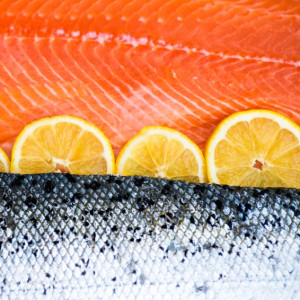Salmon is a hot topic these days and for good reason. Genetically engineered salmon was approved for US markets in November 2016. Despite petitions from both environmental and food safety groups, the FDA resisted requiring companies selling this salmon to label it as genetically modified.
Named after its producer AquaBounty Technologies, AquaAdvantage Salmon was created in a laboratory by modifying the genes of Chinook Salmon (King Salmon), mixing them with the genes of ocean pout and combining them with the genes of Atlantic Salmon to create a new fish that grows year round to full market size in half the time.
While these franken-fish aren’t yet proven unsafe, they ARE NOT proven safe either. We don’t know the potentially harmful outcome of feeding our families a laboratory experiment that messes with hormone levels and food micronutrient balance.
Personally, I’ll stick to the foods found in nature.
And at the very least, I’d like to see the FDA stand up for our rights as consumers to make our own food choices – and require that the proper labeling is in place.
Salmon is incredibly healthy – so don’t use what’s happening in the market as an excuse to avoid it!
Here are some of its amazing health benefits:
- High in omega-3 fats, your brain food to support a brighter mood. Omega-3s help maintain healthy levels of the feel good neurotransmitters serotonin and dopamine.
- One of the few foods that naturally supplies vitamin D. Vitamin D boosts your endorphins, the happy hormones that prevent anxiety and depression.
- A top anti-inflammatory food which when it comes to digestion is to blame for indigestion and irregular elimination.
- Reducing inflammation will also help prevent weight gain and weight loss resistance.
- Excellent protein-rich source of food.
Here’s how to choose salmon wisely:
Generally speaking, wild raised salmon is a better choice than farmed salmon. With farmed salmon, there are two big concerns: First, farmed salmon may be genetically modified. Second, farmed fish are often raised in tight quarters, given antibiotics (to ward off infections) and fed dye pellets which give them the color of natural salmon.
All farming isn’t created equal, so be aware of the farming practices at your local fish stores. Whole Foods, for example, sells farmed fish with integrity refusing fish raised on antibiotics and dye pellets.
The salmon I feed my family is Wild Alaskan Salmon. There aren’t any salmon farms in Alaska. You’ll be getting the real deal and supporting the local fishermen and their communities.
Salmon and sustainability:
My favorite resource for sustainable fishing practices is the Monterey Bay Aquarium in Monterey, California. They have established the Alaskan Salmon as the only low risk salmon on to meet their four-point scale of sustainability.
Quick prep ideas:
- Quick broil or grill the salmon and top with a honey and dijon mustard sauce
- Add cooked salmon to lunch salads
- Or, try my simple recipe for Herb Salmon
I’m thankful for food chains like Costco, Whole Foods and Trader Joe’s that have publicly refused to sell GMO salmon. Be sure to look for a safe food store near you.
Your Simple Action Plan:
Research your local fish markets and grocery providers to make sure you’re getting the best quality fish on your plate. If you find wild caught salmon, add it to this week’s dinner menu.




